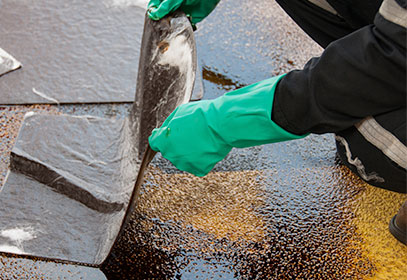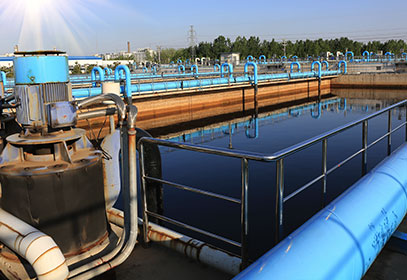Resources
Spill Cleanup Articles
Emergency Spill Cleanup & Containment
When a spill occurs at work, safety relies on a fast response. These are the steps to take and best practices for spill cleanup. …
Waste Water Treatment Labeling
Waste water treatment labeling ensures that all water and flow is accurately labeled. keeping employees safe from contaminated water. …
HAZWOPER [OSHA Hazardous Waste Standard]
Crucial training for anyone who works with or near hazardous waste, the HAZWOPER standard seeks to keep workers safe and prevent environmental catastrophe. …
Hazardous Waste Disposal
Implementing proper hazardous waste disposal tools within the workplace is essential for keeping employees safe. Do you have these hazardous waste tools? …
Spill Cleanup Questions and Answers
How have spill cleanups evolved over time?
From oil spills to chemical spills, these incidents can cause significant damage to people, the environment, and local communities. Over the years, there have been some large-scale spills which have made worldwide news and created long-term consequences. Off the back of these events, the success of the cleanups have provided learnings which can be implemented… …
What are OSHA requirements for cleaning a blood spill?
Anytime there is a spill in the workplace it needs to be correctly cleaned up. When it is the blood that is spilled, however, there are going to be several requirements for OSHA to make sure that everyone is safe. The most common type of blood spill in most workplaces is when someone is injured… …
What does SPCC stand for?
SPCC stands for spill prevention, control, and countermeasure. It is a system designed to provide instructions to companies that work with large amounts of oil. One gallon of oil spilled into water can contaminate up to one million gallons of water, which is why it is so important to have the right processes in place.… …
What are the benefits of having spill kits?
Probably the most beneficial component of a spill kit is that they are pre-packaged with all the materials that will be needed in the spill clean-up procedure. Once a spill occurs time is of the essence and being able to quickly grab the kit will ensure the spill is addressed immediately and effectively. Workers should… …
What are the specific steps to containing a spill?
When it comes to cleaning up chemical spills, we’ve outlined handling the spill in nine simple steps, as follows: Evaluate the risk: Immediately after a spill occur you will want to ask yourself a few questions that will determine your actions in the next steps. First, identify the liquid. Is it dangerous to breathe? Is… …
What are types of spills that have specific clean-up procedures?
Usually, a universal spill kit, a biohazard spill kit, or an oil spill kit, will get the job done of absorbing and cleaning up a spill. The following six substances however require specific tools or procedures to be used in the clean-up process. (Remember to refer to Safety Data Sheet’s and OSHA’s guidelines to these… …
What are different absorbents used for spill clean-up?
Sorbents, also referred to as absorbents, are specifically formulated for the spill they are intended to clean the spill. Absorbents are any materials that have the ability to quickly soak up a type of liquid. The following are four different categories of sorbents that can often be found in a spill kit. Mats, pads, and… …
What PPE is included in spill kits?
Personal protective equipment (PPE) is a crucial component in any spill kit whether it is a universal kit or a biohazard kit. The following are examples of PPE (from Creative Safety Supply’s Spill Kit User Guide) that can be found in a variety of kits and should be considered during the purchasing process. Eye and… …
What should I include in spill kit training?
Like any other safety or hazardous material program in place, an employer or safety manager will need to have a training program specifically focused on spill kits and spill response operations. These trainings will need to be documented and thorough as those who understand procedures are less likely to panic in an emergency. The training… …
How do I choose the right spill kit for my facility?
The first step in choosing an appropriate spill kit that suits the needs of the workplace is to take an in-depth assessment of the facility. In this step it will be determined the kind(s) of spill kits that are needed, the size(s) they should be, and how many will be necessary. The following are steps that… …
What is in a biohazard spill kit?
Biological hazards present a unique set of risks because they pose a threat to the health of a living organism, most often humans. Because there is a risk of potentially infectious materials (including but not limited to blood, body tissues, organs, and other bodily fluids), it is important to plan and be prepared for a… …
Does OSHA have spill kit requirements?
Although OSHA recognizes that hazardous site clean-up plans and procedures will be specific to the workplace, OSHA has published the Hazardous Waste Operations and Emergency Response Standard (HAZWOPER) that applies largely to operations regarding hazardous substances. These standards include a written and implemented safety and health program comprised of the following, as from the HAZWOPER… …
How many times can a spill kit be used?
Spill kits are designed for one-time use and one-time use only. The contents of a spill kit, and the spill kit itself are all designed for one-time use. The PPE included in a kit (save for respirators which should be stored elsewhere) is developed to be used in the event of a spill and to… …
Where should spill kits be located?
Firstly, the items of a spill kit should be stored in a container large enough for the spill and made out of an appropriate material to store the contents. Spill kits are ineffective if they are kept in remote corners or hidden away in a closet, or if an employee does not know where they… …
What does a spill kit usually always include?
While spill kits are designed for certain spills, all spill kits usually consist of the same three elements: PPE, sorbents, and clean-up items. Workers should be trained on the differences between materials and the limits of PPE included to ensure safety. These items include the following: Personal Protective Equipment (PPE): Whether the kit is designed… …
What does a universal spill kit contain?
Universal spill kits are the most commonly found type of spill kit in the workplace because of its ability to clean a wide range of liquids. These kits are not designed for a specific type of spill but works well to clean up oil-based products, water-based products, as well as a variety of chemicals. The… …
What are different types of spill kits?
There are several different types of spill kits depending on the liquid that is spilled. To ensure safety and prevent injuries, it is crucial to have a spill kit that can handle the spill effectively. It is also advised to keep multiple kits on site due to the fact that spill kits are a one-time… …
What does spill clean-up entail?
A spill in the workplace can cause a variety of hazards and risks to employees. Spilling chemicals or other corrosives pose an obvious threat, but spills also pose a slipping hazard. It is important for a facility to be prepared for a spill at any given moment, and for workers to understand the proper procedures… …


![HAZWOPER [OSHA Hazardous Waste Standard]](https://www.creativesafetysupply.com/content/images/articles/hazwoper-thumb.jpg)







